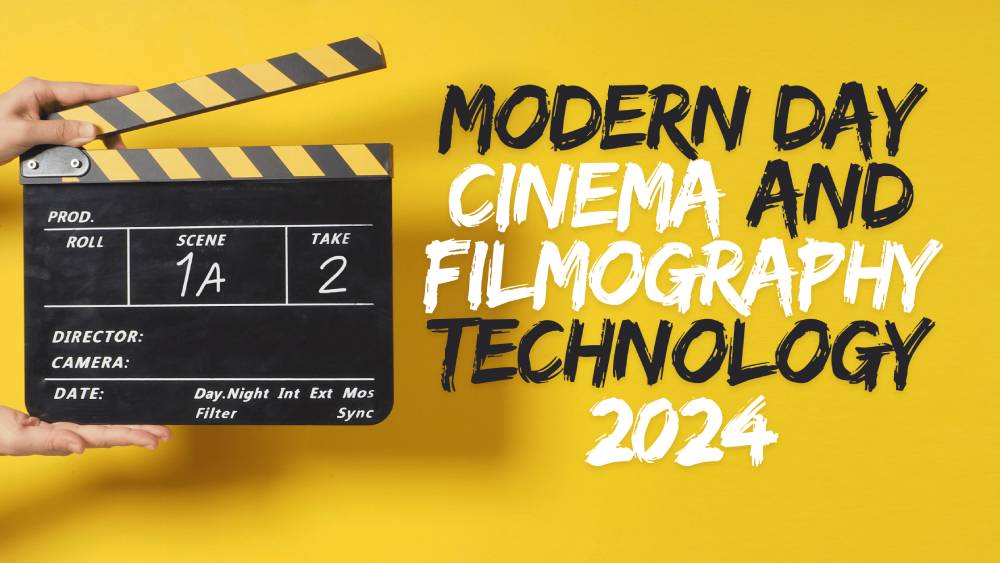
The world of cinema is constantly evolving, and 2024 is proving to be a particularly exciting year for technological advancements in filmmaking. From jaw-dropping visual effects to immersive sound design and revolutionary virtual production techniques, these innovations are pushing the boundaries of storytelling and audience experience. As we come to a close of Q1 2024, the horizon is ablaze with groundbreaking innovations that promise to revolutionize the way films are made and experienced. Find out all about cinema and filmography technology.
1. The Continued Rise of LED Volume and Virtual Production
Gone are the days of green screens! LED (Light-Emitting Diode) volume stages are rapidly transforming filmmaking. These massive enclosed environments feature high-resolution LED panels displaying computer-generated backgrounds in real-time. Actors can interact with these virtual sets, creating a more realistic and immersive experience compared to traditional green screen techniques.
This technology, also known as virtual production, streamlines the filmmaking process. Directors can see the final environment on set, allowing for quicker feedback and adjustments. Additionally, LED volumes can reduce the need for extensive location scouting and shooting, saving time and resources.
Pioneering Examples
The hit Disney+ series “The Mandalorian” is a prime example of LED volume in action. The technology has also been used in major films like “Avengers: Endgame” and “The Lion King (2019 remake)”.
Technical Dive
LED volumes utilize high-powered graphics processing units (GPUs) and specialized software like Unreal Engine or Unity to render the virtual environments. Real-time motion capture technology can further enhance the experience, allowing for seamless integration of actors and virtual elements.
2. High Frame Rate (HFR) and Beyond
For years, the film industry has adhered to the 24 frames per second (fps) standard. However, a growing trend is the adoption of High Frame Rates (HFR), which can display 60 fps or even 120 fps. This creates a smoother, more lifelike image, particularly for fast-paced action sequences. While some may find the initial shift jarring, HFR has the potential to enhance the visual experience significantly.
Challenges and Considerations
HFR content requires specialized cameras and projectors, which are not yet universally available in theaters. Additionally, some argue that the increased detail can expose imperfections and make the film feel less cinematic.
HFR in Action
Peter Jackson‘s “The Hobbit” trilogy and Ang Lee‘s “Billy Lynn’s Long Halftime Walk” were early adopters of HFR technology. James Cameron’s highly anticipated sequel, “Avatar: The Way of Water,” also utilized HFR tech.
3. The Evolution of 3D and Immersive Cinema
While 3D cinema saw a decline in recent years, advancements are aiming to reignite interest. New 3D technologies are focusing on improved brightness, reduced eye strain, and glasses-free viewing experiences. Rise of virtual reality (VR) and augmented reality (AR) could potentially revolutionize immersive storytelling.
VR and AR in Film
VR experiences can place viewers directly within the film’s world, while AR could overlay digital elements onto the real world, creating interactive narratives. Though still in their early stages, VR and AR have the potential to redefine the way we experience cinema.
Technical Considerations
VR and AR experiences require specialized headsets and software. Content creators will need to develop new storytelling techniques specifically tailored to these immersive formats.
4. Artificial Intelligence (AI) in Filmmaking
AI is making its way into various aspects of filmmaking. From automating tedious tasks like color grading to generating realistic special effects, AI can streamline workflows and enhance production efficiency. Additionally, AI could be used for facial recognition and motion capture, further blurring the lines between reality and animation.
Ethical Considerations
While AI offers exciting possibilities, ethical concerns must be addressed. Who owns the rights to AI-generated content? How can bias be prevented from creeping into AI algorithms used in filmmaking?
Examples of AI in Film
Films like “Blade Runner 2049” utilized sophisticated AI to create its visually stunning environments. AI is also being used for crowd simulation and background character generation.
5. The Rise of Cloud-Based Workflows
Cloud storage and computing solutions are transforming how films are made. Footage and editing tools can be accessed from anywhere with an internet connection, fostering greater collaboration and remote work options. This is particularly beneficial for international productions and geographically dispersed teams.
Security Concerns
As reliance on the cloud increases, robust security measures are crucial to protect sensitive film data from unauthorized access.
A Look into Cinematography and Filmography Equipment: Cameras, Lenses and More
Cinema and filmography are heavily influenced by the tools used to capture the moving image. Let’s explore some of the latest advancements in camera and related equipment:
1. High-Resolution Cameras and Large Format Sensors
The megapixel race continues, with cameras now boasting resolutions exceeding 8K. This allows for incredibly detailed captures, ideal for large format projection and future-proofing content for even higher resolution displays. Additionally, large format sensors offer shallower depth-of-field and superior low-light performance, giving cinematographers more creative control over the look and feel of their films.
Sensor Innovation
Dual native ISO sensors are becoming increasingly popular. These sensors offer exceptional low-light performance without sacrificing image quality at higher ISOs. Additionally, advancements in color science are leading to more accurate and vibrant image capture.
Advanced Lens Technologies
Lenses play a vital role in shaping the visual language of a film. Here’s a look at some exciting developments:
- Anamorphic Lenses
Offering a wider field of view with a distinctive horizontal squeeze, anamorphic lenses continue to be a popular choice for creating a cinematic aesthetic. Modern anamorphic lenses are becoming faster (wider maximum apertures) and lighter, offering greater creative flexibility.
- Zoom Lenses vs. Prime Lenses
While prime lenses offer superior image quality and low-light performance, high-end zoom lenses are narrowing the gap. These zooms boast impressive sharpness and constant apertures throughout their focal range, making them more versatile for various shooting scenarios.
- Focus Control Systems
Wireless lens control systems are gaining traction, allowing focus pullers to precisely control focus from a distance. This is particularly beneficial for complex camera setups or Steadicam shots.
Camera Stabilization Systems
Smooth, stable footage is essential for professional filmmaking. Here are some of the latest tools for achieving this:
- Internal Image Stabilization (IS)
Many cameras now offer impressive in-body image stabilization, allowing for handheld shooting or smooth tracking shots without the need for external equipment.
- Electronic Gimbal Stabilizers
Compact and versatile, electronic gimbals like handheld rigs or larger Steadicam systems provide exceptional stabilization for dynamic camera movements.
- Drone Technology
Drones equipped with high-resolution cameras are revolutionizing aerial cinematography, offering breathtaking perspectives and unique filming opportunities.
4. Camera Support Systems
While tripods remain a mainstay for static shots, camera support systems are becoming more specialized:
- Remote Heads
These motorized heads allow for precise camera movements, ideal for capturing smooth pans, tilts, and time-lapse sequences.
- Dolly Tracks and Jib Arms
Dolly tracks provide smooth linear camera movements, while jib arms offer dynamic vertical and horizontal movements, adding production value to a shot.
5. Filmography Accessories and Monitoring
A range of accessories enhance the filmmaking process:
- High-Bright Monitors
Modern monitors offer exceptional brightness and color accuracy, allowing filmmakers to accurately judge exposure and color balance on set.
- Wireless Video Transmission Systems
Real-time wireless transmission allows directors and other crew members to monitor the camera feed from remote locations, improving collaboration and efficiency.
- Camera Drones and Remote Control Systems
Advanced camera drones offer filmmakers a unique aerial perspective, while wireless focus and zoom controls allow for precise adjustments during flight.
These trends represent just a glimpse into the ever-evolving world of cinema technology. As these technologies continue to develop and converge, we can expect even more immersive, realistic, and awe-inspiring cinematic experiences in the years to come. Expect further integration of AI and machine learning for tasks like autofocus, automatic exposure control, and even real-time image analysis to optimize picture quality.
SOURCE:
